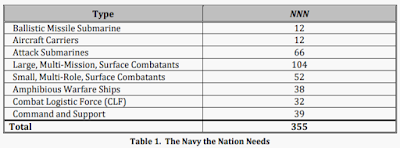We cannot expect to be able to effectively tell our Navy's story - and build public support for our Navy - if we cannot communicate in clear, understandable, and consistent terms.
Both inside our lifelines, and especially outside our lifelines, one of the most significant self-generated barriers we have to effective communications is the self-parody level of acronym use. It seems that we feel the need to create new rafts of idea-choking acronyms every FITREP cycle.
It seems we're doing it again. In an critical document we would want a broad spectrum of people to read, quote, and discuss, Report to Congress on the Long-Range Plan for Maintenance and Modernization of Naval Vessels for Fiscal Year 2020, we auto-chaff our message with this unnecessary cloud;
The National Defense Strategy provides the overarching guidance and high-level requirements for sustaining the Navy the Nation Needs (NNN).It appears that someone spawned this about 18-months ago, and I really wish we would stop trying to make NNN happen. I know it has become shorthand for 355, but stop. What do we do next in this farcical dance, abbreviate it to "3N?"
Someone at NAVSEA needs to be put in the time-out chair.
I think we are moving away from 355 anyway, so we'll see what the report for 2021 says - ringing in the Terrible 20s.
I stand that we will never see 355 outside Chinese expansion east, but here is the vision:
Now let's look to the substance of the report. As we discussed before, it is fun to talk about ship numbers and programs etc ... but that isn't where the greatest challenge is. You can buy all the fancy new things you want, but if you can't maintain them properly, they become tied to the pier and combat ineffective.
We have a significant issue right now.
Sustaining the 355-ship fleet will require changes to both public and private industrial capability and capacity. Current infrastructure will require update and refurbishment to support modern classes of ships and repair. Likewise, additional dry docks will be needed to address the growing fleet size. Navy and industry partners must create work environments where talented Americans will want to work and contribute to the national defense. This includes investments in updating facilities and capital equipment, and as well as providing that workforce training that is both modern and relevant and compensation commensurate with the skill required to repair Navy ships. Finally, we must avoid feast and famine cycles that erode both the repair industrial base and the underlying vendor supply base. Consistent funding matched to steady demand for work will enable the repair base, public and private, to grow to meet the needs of the 355-ship Navy.Read the whole report with the commentary to the numbers ... but this just screamed out to me as the above the fold issue. We can't service what we already have in the fleet.
Yes, I'm a spreadsheet guy - I think the numbers speak just fine for themselves;
If I were in Congress - and thank you Buddha I am not - this would get first billing.
It is the adult thing to do. It is the long-term thing to do ... and you know what - there are A LOT of very good jobs that come with shipyards and maintenance.
A lot.
Oh, and for (R) and (D) politicians who mean well and the best for their Navy; it is the right thing to do.












No comments:
Post a Comment